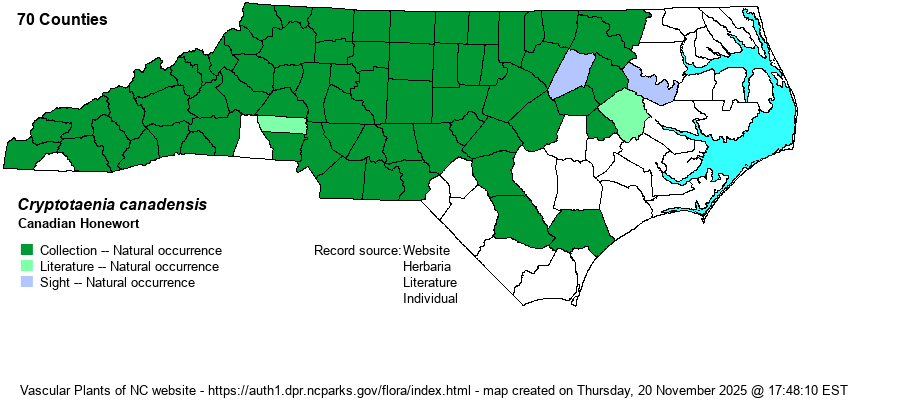| Author | (L.) de Candolle | |
| Distribution | Throughout the Mountains and Piedmont; in the Coastal Plain found mainly along brownwater river floodplains, and also into a few other counties with very rich soils.
This is a widespread Eastern species, found in nearly all counties in its range, from eastern Canada south to western FL and northeastern TX. It is scarce in Coastal Plains. | |
| Abundance | Common in the Mountains and Piedmont. Fairly common along the Roanoke and Cape Fear rivers into the central Coastal Plain, but very rare elsewhere in that province. | |
| Habitat | This is a species of rich hardwood forests and small forest openings -- typically in a bottomland forest, rich cove forest, or moist lower slopes of Mesic Mixed Hardwood Forests or Basic Mesic Forests. |
| Phenology | Blooms in May and June, and fruits from June to August. | |
| Identification | This is a familiar umbel species of rich forest interiors, one of the few such members of the family growing in deep shade of such habitats. It has a fairly slender stem, growing to about 2 feet tall. The alternate stem leaves are divided into 3 leaflets, with a leaf stalk up to 1-inch. Each of the 3 leaflets is ovate, about 4-5 inches long and 2 inches wide, one or two often partly cleft to the midrib, but all are clearly serrated on the margins. These leaves look like those of many other species, but the umbels are very slender-looking, owing to tiny flowers; the fruits are very narrow and point upwards, often catching your eye more than do the tiny white flowers. Experienced biologists can identify this species just by its leaves, but others may require the flowers or fruit before being confident in naming this species. | |
| Taxonomic Comments | None
| |
| Other Common Name(s) | Honewort | |
| State Rank | S5 | |
| Global Rank | G5 | |
| State Status | | |
| US Status | | |
| USACE-agcp | FAC link |
| USACE-emp | FAC link |

